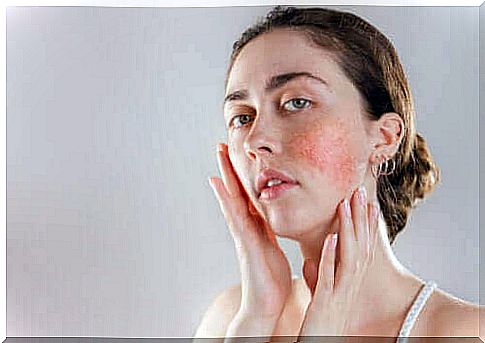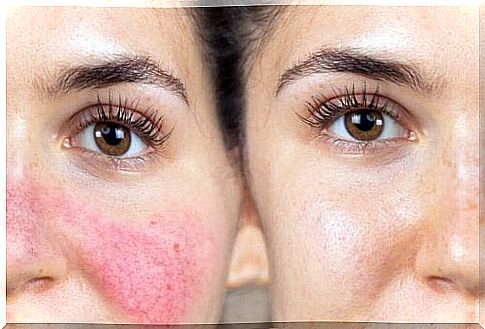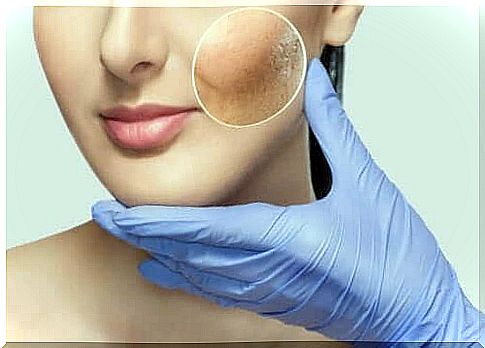Reactive Skin: Symptoms, Causes And Treatment

Reactive skin is a fairly common problem that is about violent hypersensitivity to certain factors. This disorder manifests itself in the form of redness, dryness, shine and irritation, which appear suddenly. In many cases, the causes are unknown.
This phenomenon is more common in women. Experts actually estimate that one in three women may suffer from reactive skin. Some of them experience symptoms so often that they end up interpreting it as “normal” when in fact they are not. In fact, many dermatologists also find it difficult to classify this type of skin.
Reactive skin is also often referred to as sensitive skin, irritable skin, intolerant skin and so on. But these concepts are not precise. Reactive skin is not a disease in itself, but it does produce discomfort in those who experience it. What causes so reactive skin? And what can people do to keep their symptoms under control?
What is reactive skin?
Until recently, people referred to this disorder as “sensitive skin”. Dermatologists believe, however, that the term “reactive skin” is more accurate. It is defined as a type of skin that produces unpleasant sensations including a burning sensation, itching, pain or burning as a result of a substance that should not produce these types of reactions.
Skin reactions occur only when no other disorder can explain the changes in a person’s skin. In other words, the symptoms cannot be explained as an allergy to a particular substance or the presence of aggressive substances such as an abrasive soap.
Another characteristic of this disorder is that it generally occurs with breaks. In other words, the symptoms appear and disappear again. Applying cosmetics is often what triggers it.

The causes of reactive skin
Science has not yet understood the reasons why reactive skin exists. However, there are three hypotheses that can explain this phenomenon, which you will be able to read below.
- Epidermal hypothesis. It says that the skin barrier located in the epidermis is defective. It thus does not adequately protect the skin from external substances.
- Biochemical hypothesis. This hypothesis indicates that these cases are abnormalities in channels known as TRP (transient receptor potential channels). These are located in the outer part of the epidermal cells and in nerve endings.
- Neurogenic hypothesis. This hypothesis indicates that people with reactive skin have a lower number of nerve fibers in the epidermis. At the same time, they show a greater release of inflammatory mediators.
At the same time, experts have determined that there are some substances in particular that lead to reactive skin. This list includes the following:
- Abuse of cosmetics
- Sustained exposure to certain chemicals
- Environmental pollution
- Treatments with heat and radiation
- Extreme temperatures
- Certain drugs
- Stress
- Lack of sleep
- Low humidity
- Alcohol
- Strong foods or very spicy dishes

What steps must be taken to prevent it?
People who experience skin reactions will need to be careful with the products they use. It is best to talk to a dermatologist so that the professional can determine which specific products are best for each case.
It is important to make certain adjustments in the beauty routine as well as to optimize the cleansing and hydration of the skin. Applying and reapplying sunscreen every two to three hours is also basic.
At the same time, it is important to avoid cosmetics that contain potential irritants. Examples are propylene glycol, trichloroacetic acid, fruit acids and alcohol.
At the same time, people with reactive skin should avoid moisturizing creams with retinoids and hydroxy acids. In addition, rejuvenating products and highly exfoliating products can also cause irritation.
To cleanse and moisturize reactive skin, it is best to use creams instead of other products. These products should be applied by dabbing them on the skin without causing friction.
Reactive out: Concluding conclusions
Treating reactive skin is as complex as diagnosing it. First, a dermatologist must rule out other possible disorders. He or she can then indicate which products are best for each patient. In the same way, the professional must decide which products trigger the reaction.
Sometimes a doctor recommends drugs that are typically used to treat atopic skin, which have also been shown to be effective in cases of reactive skin. In any case , it is essential that people with this skin condition moisturize their skin. It is not only about applying moisturizing creams, but also drinking plenty of water.









